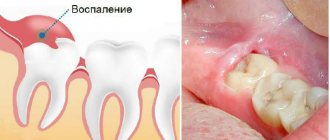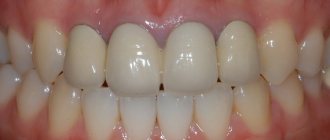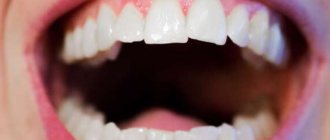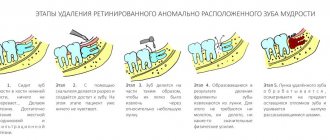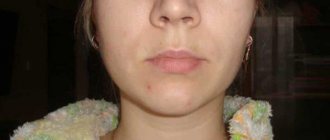For many people, wisdom teeth have difficulty erupting because they do not have enough space in the jaw. In this case, dentists recommend removing them to prevent crooked teeth and other problems. Extraction of third molars is a complex operation that must be performed by a highly qualified dental surgeon.
After surgery, it is important to follow your doctor's recommendations.
- For the first few days after surgery, you should not rinse your mouth or drink through a straw, as this may wash out the blood clot covering the wound.
- Brush your teeth with a soft-bristled brush and eat only soft foods to avoid damaging the socket.
- Minimize physical activity, do not visit the sauna or take a hot bath.
- If the pain is severe, take painkillers. To relieve swelling, you can apply ice to your cheek.
- Stop drinking alcohol and smoking.
It is important to monitor the wound remaining at the site of the extracted tooth until it heals completely.
What does the white coating mean?
Did you find that your gums turned white after wisdom tooth removal? There is no cause for concern as this is normal. White plaque may be on the hole and around it. The reason for its appearance is fibrin, a protein that ensures tissue regeneration. It performs several functions:
- prevents bleeding,
- closes the wound and protects it from bacteria,
- helps reduce the diameter of the hole,
- accelerates the resorption of a blood clot.
White plaque cannot be removed. Because of this, pain increases and the wound healing time increases. Damage to the protective film can lead to severe bleeding and infection of the socket.
Stages of socket healing
Removing even the most decayed tooth is a traumatic surgical procedure. When the crown and tooth roots are removed, blood vessels and nerve fibers rupture. All this causes pain, discomfort in the patient, and provokes bleeding.
But the processes taking place are natural. The body knows how to cope with injury - protect the wound from bacteria, restore the damaged area, speed up healing. Bleeding after removal plays two important roles - it washes away pathogenic microflora and creates a natural protective barrier in the form of a blood clot.
A blood clot after tooth extraction is the result of blood clotting in an open socket, a protective layer between damaged tissues and bacteria, the basis for the formation of gums and bone tissue at the site of the extracted unit.
There are three stages of healing after tooth extraction:
- after 2-4 hours - formation of a blood clot;
- on days 2-4 - the appearance of granulation tissue;
- after 1-2 weeks - closure of the hole, formation of bone tissue.
Possible complications
In rare cases, white gums after wisdom tooth removal may indicate the development of complications.
- Alveolitis. Inflammation of the socket due to infection by pathogenic microorganisms. The causes of development include non-compliance with personal hygiene rules and doctor’s recommendations. The main clinical manifestations are throbbing pain, gray plaque on the wound, and swollen lymph nodes.
- Periostitis. Inflammation of soft tissues and periosteum. Develops due to poor quality dental treatment and jaw injuries. It is a small growth on the gum that can be red, yellow or white.
Clinical researches
As a result of clinical experiments using the Asepta series of products, which were carried out at the Kazan State Medical Academy N.V. Berezina, E.N. Silantieva, S.M. Krivonos, the effectiveness of the Asepta line of drugs has been proven as a means of etiotropic and symptomatic therapy as part of the complex treatment of patients with chronic inflammatory periodontal diseases.
Sources:
- The use of drugs from the Asepta line in the complex treatment of inflammatory periodontal diseases (N.V. Berezina E.N. Silantyeva S.M. Krivonos, Kazan State Medical Academy. Kazan.) N.V. BEREZINA, E.N. SILANTIEVA, S.M. KRIVONOS Kazan State Medical Academy
- The effectiveness of the use of Asept “adhesive balm” and Asept “gel with propolis” in the treatment of chronic generalized periodontitis and gingivitis in the acute stage (Municipal Dental Clinic No. 4, Bryansk, Kaminskaya T. M. Head of the therapeutic department Kaminskaya Tatyana Mikhailovna MUZ City Dental Clinic No. 4, Bryansk
- The effectiveness of the use of Asepta balm in the treatment of patients with inflammatory periodontal diseases (Doctor of Medical Sciences, Professor Elovikova T.M., Department of Therapeutic Dentistry, USMU. Yekaterinburg) Doctor of Medical Sciences, Professor Elovikova T.M. Department of Therapeutic Dentistry, USMU. Ekaterinburg
- Report on clinical trials to determine/confirm the preventive properties of commercially produced personal oral hygiene products: mouth rinse "ASEPTA PARODONTAL" - Solution for irrigator." Doctor of Medical Sciences Professor, Honored Doctor of the Russian Federation, Head. Department of Preventive Dentistry S.B. Ulitovsky, doctor-researcher A.A. Leontiev First St. Petersburg State Medical University named after academician I.P. Pavlova, Department of Preventive Dentistry.
When do you need a doctor's help?
If you experience pain 3-5 days after wisdom tooth removal, you should consult a specialist. Reasons to visit a dentist are also:
- accumulation of pus in the wound,
- bad breath,
- increase in body temperature,
- bleeding gums,
- swelling of the lip or cheek,
- pain when eating.
Don't expect unpleasant symptoms to disappear. Contact your doctor even if you experience minor oral discomfort.
Symptoms and treatment of leukoplakia -
Leukoplakia is characterized by the fact that under the influence of various irritants, keratinization of the epithelium of the oral mucosa begins to occur. This process occurs due to a violation of the desquamation of the epithelium in those areas of the mucous membrane that is exposed to pathological irritants. These irritants can be:
- smoking,
- sharp edges of carious teeth,
- overhanging edges of fillings,
- malocclusion,
- excessive consumption of spices, very hot foods,
- poorly manufactured removable dentures,
- the presence of artificial crowns made of different metals on the teeth, which gives rise to galvanic currents in the oral cavity.
White spots on the gums with leukoplakia: photo
Symptoms of leukoplakia:
The main element of leukoplakia is a white plaque, which may rise above the level of the mucous membrane, but may not rise (as in Fig. 4). In addition, the plaque can have both clear and blurred boundaries. Patients most often call such plaques white spots. As a rule, white spots do not bother their owners and are discovered completely by accident.
In some cases, patients may be concerned about the roughness of the mucous membrane at the site of the white spot, as well as the fact that the mucosa in this place may rise above the level of the mucosa. In some cases, cracks and ulcers may appear on the surface of the stain; in this case, the patient may also be bothered by burning and pain. If leukoplakia develops as a result of smoking, then, as a rule, patients first of all complain of dryness and burning of the oral mucosa (24stoma.ru).
Treatment of leukoplakia will primarily involve eliminating exposure to the irritating factor. Those. it will be necessary to eliminate the impact of the overhanging edge of a filling or crown, replace old low-quality dentures, normalize oral hygiene, and of course, solve something with the effects of nicotine and hot dry air on the mucous membrane (which occurs when smoking).
Only after this are prescribed keratolytic agents for topical use (3-5-10% salicylic acid, celandine infusion), and vitamin therapy. Applying any treatment procedures without eliminating the causative factor will be useless.
The danger of leukoplakia –
Leukoplakia belongs to the category of precancers. Malignancy of leukoplakia, i.e. its transition to cancer occurs in 15-75% of cases (depending on its form). Therefore, if you do not want to develop cancer of the oral mucosa, you need to urgently go to the dentist and look for the cause of its appearance. But in the photo below you can see photos of two clinical cases when leukoplakia transformed into a malignant tumor of the oral mucosa and the red border of the lips.
Cases of cancer associated with leukoplakia –
Now about the production of metal ceramics in our clinic
Temporary crowns are made for you before preparing your teeth so that you don’t walk around for a single day with ground-down “stumps” that scratch your tongue and lips and frighten those around you. The doctor carefully, and therefore slowly, fits these crowns to your teeth and gums. Yes, yes, even temporary crowns should under no circumstances irritate the gums. And this is achieved by high-quality, which again means quite a long work, by preparing the teeth, with their obligatory polishing and smoothing of the ledge, designed to protect the gums from the pressure of the crown.
Impressions for permanent crowns are taken using modern, absolutely painless gum retraction technology of the 21st century - the gums are moved back not with a traumatic retraction thread, but with a special composition that does not cause the slightest pain. The quality of the impression material plays an important role at this stage.
When your new teeth are ready, they must be tried on, taking into account your wishes; the fit of the crowns to the ledge and gum is very carefully checked in order to exclude any pressure on it, as well as contacts with neighboring teeth so that they are tight and pieces of food do not fall between the teeth ( a very common mistake when making crowns). The crowns are then fixed to temporary material so that the color, shape and ease of use can be checked in natural conditions. If necessary, the crowns are adjusted, achieving absolute harmony and comfort. And only after some time the metal ceramics are fixed with permanent cement.
Of course, all these manipulations take time, and high-precision technologies that guarantee quality, by definition, cannot be cheap.
You wouldn’t believe it if they offered you to buy “a car for the price of a bicycle”? What is the difference between metal-ceramic crowns?
Do you want to buy something inexpensively that you simply won’t be able to use in the future?
After all, as more than 20 years of practice and simple mathematics show, the production of cheap metal ceramics, which is promoted on every corner, is much more expensive. And not in the distant future, but in the quite foreseeable.
Prevention of gum disease
Preventing a disease is easier than treating it, especially after the disease becomes chronic, so preventive measures are important to maintain the health of the gums and the entire oral cavity. Among them:
- Daily hygiene, including actually brushing your teeth, using a special thread (floss) for interdental spaces, rinsing your mouth with refreshing solutions, and using tongue scrapers. Brushes, pastes and rinses are selected individually; may have a purely hygienic or therapeutic and prophylactic purpose (to reduce the sensitivity of the enamel, bleeding).
- Periodic visits to the dentist - preferably every 6 months, if there are no complaints and the gums are healthy. In addition to a general examination and care recommendations, it is advisable to undergo a professional cleaning procedure by a dental hygienist. To eliminate dental plaque, a combination of manual (mechanical removal with curettes) and hardware techniques is used, the most popular of which are:
- air-flow treatment – suitable for removing soft or small amounts of hard plaque. The enamel is exposed to a directed jet of a finely dispersed mixture of air, soda, and water under strong pressure. Used in children from 2.5 years old;
What does air flow look like? - ultrasonic cleaning – used to destroy hardened deposits, including those accumulated in gum pockets. It is produced by a device with a hook-shaped nozzle, through which ultrasonic vibrations are applied to the treated area, causing the destruction of plaque. Used in adults and children over 14 years of age.
Tips to help keep your teeth and gums healthy
In addition to hygiene measures, maintaining health in this area is facilitated by:
- Balanced diet. It should include products that are useful for maintaining dental health - dairy (cheese, cottage cheese, kefir), low-fat fish, fiber-rich vegetables and fruits that have not been heat-treated. You need to drink less strong tea and coffee, and give up sweet carbonated drinks. To compensate for the deficiency of nutrients, it is allowed to take correctly selected tablet forms of vitamins (A, C, E, D), microelements (calcium, phosphorus, fluorine).
- Refusal of bad habits - drinking alcohol, smoking, biting nails, and other hard objects (pens, seeds).
- General strengthening of the immune system by hardening, regular walks in the fresh air, doing gymnastics, maintaining a sleep schedule, and avoiding nervous overload.
Healthy gums and teeth are the key to a beautiful smile in photographs, as well as the absence of discomfort in life. Therefore, you need to carefully take care of them yourself, with the help of doctors if necessary.
Questions about prosthetics
Elena
2018-11-17 15:17:00
Hello! I have had temporary plastic crowns for a year and a half now, 8 teeth on the upper jaw and 5 below. The teeth are all cured, some have inlays. These crowns have already been removed and filed several times, the top one is already broken, they glued it together. The orthopedist is in no hurry to do his job, makes an appointment once every month and a half. About five months ago, I began to experience constant itching and a feeling of fullness in the upper jaw, in the place where the crowns are located. Two months ago, it became painful to press on the gum above one tooth, there was no redness as such, and until recently I had a rash on my wrists and elbows, it went away after taking enterosorbents. I have a general malaise and my lips are constantly dry, maybe it has nothing to do with the problem of my teeth. The doctor himself says that wearing plastic is very harmful and at the same time it’s dragging. the itching was bothering me. I have a question for you, is this an inflammatory process or what could it be? I read that plastic releases a monomer that has a toxic effect. What can be done in my case. Thank you if you don’t ignore my question
Shinberg Oleg Emilievich
chief consultant, orthopedic dentist
Dear Elena, it is indeed very harmful to use temporary plastic crowns made by polymerization for a long time, and indeed, they emit a monomer that is harmful to the gums. Therefore, it is completely incomprehensible to me why your doctor is delaying so long with the manufacture of permanent structures. At a minimum, it is necessary to replace your temporary crowns with temporary crowns made by milling. They do not release monomer, because blanks for milling are made in the factory. Unfortunately, I can’t give any more advice without an examination and consultation, since the cause may not be isolated. In any case, I recommend changing your dentist, because, for some reason, he is clearly not interested in you.
Natalia
2018-10-05 17:02:00
Good afternoon, the 5th tooth is broken, only the root remains. What can be done with it? Or just an implant? Tooth from above
Shinberg Oleg Emilievich
chief consultant, orthopedic dentist
Dear Natalya, in your case there are two options: either tooth extraction followed by implantation and making a crown, or preserving the tooth root and then making a crown. This will depend on the level of the root fracture. Unfortunately, it is impossible to answer the question more accurately without consultation and an x-ray.
Natalia
2017-12-07 18:06:00
Good afternoon I am replacing the upper chewing teeth. It is necessary to place 4 units on teeth 14,15,16,17. The doctor recommends all-ceramic veneers. Initially they planned simple crowns, but today I’m convinced. I doubt it. I read that it is not advisable to put veneers on chewing teeth: they are expensive and less reliable. Is that true? There are no problems with gums or allergies to metal ceramics. The price of a veneer is of course more expensive. Thanks in advance for your answer.
Shinberg Oleg Emilievich
chief consultant, orthopedic dentist
Dear Natalya, good afternoon! The advantage of veneers over crowns is that they require much gentler preparation. Veneers, unlike crowns, do not cover all surfaces of the tooth and the thickness of the walls of the veneer is much thinner than the walls of the crown. As for the reliability and strength of veneers, modern materials make them even more durable and reliable than those on a metal-ceramic crown. Therefore, contraindications for installing veneers on chewing teeth are no longer relevant today. Of course, the price of a veneer is higher than that of metal-ceramic crowns, but the price is compensated by the greater reliability of the veneer and the durability of the structure.
Catherine
2017-11-07 20:52:00
Hello! I would like to know how much it will cost to install ceramic veneers? Thank you.
Shinberg Oleg Emilievich
chief consultant, orthopedic dentist
Good afternoon Ekaterina! The cost of making a ceramic crown (veneer) is 54,000 rubles.
Varvara
After visiting the dentist, it turned out that I would have to have a sinus and implantation of 2 teeth. I'm terribly afraid of the dentist, but I still have to do it. I’ve heard a lot about dental treatment in a dream, but I don’t quite understand how this happens and what the consequences might be after this method of treatment. I would like to consult an experienced specialist on this issue. Tell me if there are any contraindications for carrying out such a procedure and whether you will feel lethargic and drowsy afterwards. I drive all the time, so I want to know if I will be able to drive a car after leaving the office and how will I feel after that?
Shinberg Oleg Emilievich
chief consultant, orthopedic dentist
Dear Varvara, treatment in dreams really does exist, and indeed this method can almost completely relieve stress from people who, like you, are terrified of the dentist. The procedure takes place with the participation of an anesthesiologist and is completely safe. As for the question of being able to get behind the wheel immediately after leaving the office, this is categorically not recommended.
Symptoms
In addition to visual changes in soft tissue, the following symptoms may occur:
- pain when eating and brushing teeth;
- itching;
- swelling of the mucous membrane;
- the appearance of bleeding;
- abundant plaque on the teeth and the appearance of mineralized deposits.
Symptoms depend on the cause of the pathology and on the individual characteristics of the patient’s body. Eliminating cyanosis of soft tissues is the first step in treatment and in making the patient feel better.
When to seek help from a specialist
- The blue color of the gums does not subside for more than four to five days;
- Blue discoloration is accompanied by swelling and bleeding;
- Acute pain appears that is not relieved by painkillers;
- Body temperature can rise to 38 - 39 degrees;
- Loss of strength, general weakness.
Ignoring the disease is fraught with the development of serious complications, including the formation of an intraoral cyst.
How to speed up the healing of a hole
Fast recovery processes are facilitated by suturing during tooth extraction. The sutures tighten the edges of the gum mucosa, which guarantees:
- stable position of the blood clot in the socket;
- reducing the risk of developing inflammatory processes;
- rapid wound healing.
Surgeons practice suturing for complex removals, but the patient can always independently request such a service.
